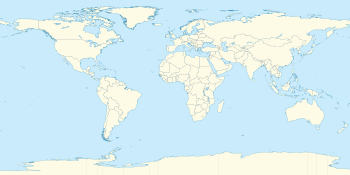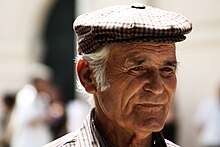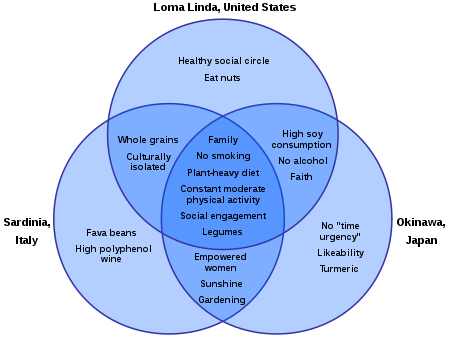Blue Zone

Blue Zones are regions of the world where a higher than usual number of people live much longer than average. The term first appeared in Dan Buettner's November 2005 National Geographic magazine cover story, "The Secrets of a Long Life".[1] Five "Blue Zones" have been posited: Okinawa (Japan); Sardinia (Italy); Nicoya (Costa Rica); Icaria (Greece); and among the Seventh-day Adventists in Loma Linda, California, based on evidence showing why these populations live healthier and longer lives than others.[2][3][4]
History[]
The concept of Blue Zones grew out of demographic work done by Gianni Pes and Michel Poulain outlined in the journal Experimental Gerontology,[5] who identified Sardinia's Nuoro province as the region with the highest concentration of male centenarians. As the two men zeroed in on the cluster of villages with the highest longevity, they drew concentric blue circles on the map and began referring to the area inside the circle as the "Blue Zone". Together with demographers Pes and Poulain, Buettner broadened the term, applying it to validated longevity areas of Okinawa, Japan and among the Seventh-day Adventists in Loma Linda, California. Buettner and Poulain, under the aegis of National Geographic, then identified and validated longevity hotspots in Nicoya, Costa Rica and Icaria, Greece.
Buettner mentions in his book that people are doing the right things for long enough, and avoiding the wrong things," there are four main things that people in those zones do in order to live healthier and longer lives, and they consist of moving regularly, which does not consist of exercise alone, but doing daily energy burst habits throughout the day. The second aspect is living with purpose, having a reason to get up every day, and living with perspective. The third aspect of blue zone populations is the social support they receive from friends and family allowing them to move through life outcomes more smoothly. Fourth but not least is the concept that most still do not understand, which is making the "healthy choice the easy choice", and not just an option. Living by these four concepts brings longevity and mental and physical benefits to one's life and society.
Blue Zones[]

The five regions that are identified in the book The Blue Zones: Lessons for Living Longer from the People Who've Lived the Longest are:[6]
- Sardinia, Italy (particularly Ogliastra, Barbagia of Ollolai, and Barbagia of Seulo): One team of demographers found a hot spot of longevity in mountain villages where a substantial proportion of men reach 100.[6] In particular, a village called Seulo, located in the Barbagia of Seulo, holds the record of 20 centenarians from 1996 to 2016, that confirms it is "the place where people live the longest in the world".[7]
- The islands of Okinawa, Japan: Another team examined a group that is among the longest-lived on Earth.[6]
- Loma Linda, California: Researchers studied a group of Seventh-day Adventists who rank among North America's longest-lived people.[6][8]
- Nicoya Peninsula, Costa Rica: The peninsula was the subject of research on a Quest Network expedition which began on January 29, 2007.[6][9][10]
- Icaria, Greece: An April 2009 study on the island of Icaria uncovered the location with the highest percentage of 90-year-olds on the planet, where nearly 1 out of 3 people make it to their 90s. Furthermore, Icarians "have about 20 percent lower rates of cancer, 50 percent lower rates of heart disease and almost no dementia."[6][11]
Residents of these places produce a high rate of centenarians, suffer a fraction of the diseases that commonly kill people in other parts of the developed world, and enjoy more years of good health.[12]
Based on research results in the fields of biogerontology and epigenetics, the term "Blue Zones" is also used for areas whose native flora grows under special conditions and can effectively counteract the aging process.[13] Forschungsgruppe Haslberger of the University of Vienna, in cooperation with the Blue Zones, research on secondary plant substances from such areas, which could have use in the area of anti-aging, neurodegenerative diseases and geriatric diseases.[14][15] In 1998, a study carried out on the eating habits of the population of Yuzurihara, where the inhabitants grew very old with the best quality of life.[16] Another research group of the University of California, in collaboration with the University of Rome La Sapienza, is investigating temporal bluezones in Italy outside of Sardinia.[17]
Characteristics[]

The people inhabiting Blue Zones share common lifestyle characteristics that contribute to their longevity. The Venn diagram highlights the following six shared characteristics among the people of Okinawa, Sardinia, and Loma Linda Blue Zones:
- Though not a lifestyle choice, they live as isolated populations with a somewhat-related gene pool (Okinawa and Sardinia, for instance, are historically-isolated islands with limited resources[18])
- Family are put ahead of other concerns
- A lower proportion of smokers within the population
- Vegetarianism being a majority diet to a greater degree
- Members of the population engaging in constant moderate physical activity
- Social engagement – people of all ages are socially active and integrated into their communities
- Whole grains and legumes are commonly consumed[19]
In his book, Buettner provides a list of nine lessons, covering the lifestyle of people who reside in blue zones:[20][21]
- Moderate, regular physical activity
- Life purpose
- Stress reduction
- Moderate caloric intake
- Plant-based diet
- Moderate alcohol intake, especially wine
- Engagement in spirituality or religion
- Engagement in family life
- Engagement in social life
Moderate, regular physical activity[]
The health benefits of regular exercise and physical activity are said to contribute to the longer life expectancy of people living in Blue Zones, alongside keeping a healthy diet, helping to prevent health problems such as cardiovascular diseases, high blood pressure, diabetes, depression, anxiety and a higher weight. The mental effects of exercising - in releasing of a variety of neurotransmitters, such as endorphins, serotonin, and dopamine chemicals - are also said to contribute. Studies within people of the Blue Zones have shown that being physically active does not mean going to the gym everyday, instead being constantly moving and trying to exercise while doing daily tasks.
Life purpose[]
The longevity of health of inhabitants of the Blue Zones is also said to be contributed to by what they consider to be their life purpose, as well as being open to both success and failure. Okinawans, for example, utilize the concept known as ikigai, meaning "a reason for being".[22]
Stress reduction[]
Inhabitants of Blue Zones also learn how to cope with stress in a healthy way, accepting that though it is important for one's life not to be overrun by it - as high levels of stress can cause serious health problems, such as high blood pressure, anxiety and depression - not all stress can be eliminated, and that some amount of stress has to be lived with and endured.[23] Some ways that people living in Blue Zones cope with stress is by having social support groups in which they confide and regularly interact with.[24]
Moderate caloric intake[]
In order to maintain a strong and healthy body, Blue Zone inhabitants, though they consume fewer calories than most, do not deprive themselves to a limited number of calories a day (in comparison to other areas). According to the United States Government project "My Plate", the average caloric intake for the American person varies according to gender and physical fitness, to between 1,500 and 2,200 calories.[25] On the other hand, traditional Okinawa diet, which incorporates the practice of "hara hachi bu" (eating up to 80% full), is associated with an average calorie intake of around 1,800 calories per day.[18]
Plant-based diet[]
The countries located in the Blue Zones consume foods that are primarily plant-based. Many of these food, such as whole grains, fruits, vegetables, nuts, legumes, seeds, and spices, coincide with the Mediterranean diet,[26] while meat, the vast majority of which being fish and lean meat, is consumed sporadically.[18]
Moderate alcohol intake[]
According to researchers, light to moderate consumption of alcoholic products, such as wine, champagne, beer and other alcoholic beverages, may provide some benefits to overall health, such as the reduction in cardiovascular problems, but being physically active and maintaining a healthy diet are shown to have greater health benefits in the long run.[27]
Engagement in spirituality or religion[]
Another contributing factor to the health of inhabitants of Blue Zones is involvement in religion and spirituality, which is associated with better health outcomes, greater longevity, better coping mechanisms and increased quality of life. The people of Blue Zones use their religion to cope, learning that serving and thinking about others is crucial.[28]
Engagement in family life[]
The inhabitants of Blue Zones engage in social support and family-oriented practices beginning in childhood, and learn that their choices and outcomes will have an impact not only on themselves, but also on their families; therefore, there is a greater drive for social cohesion and the consideration of others, as inhabitants wish to grow together and share their lives, success and failures within their families.[29]
Engagement in social life[]
Social ties, which can have a significant impact on physical health, are emphasized within the lifestyles of those living in Blue Zones, with the need for different social relationships and recognised as important to reducing stress and its related issues. Physical contact, from simple actions, such as holding hands, to higher forms of contact, such as sex, can assist the body in releasing important chemicals, such as hormones, which have biological benefits on top of mental, emotional, and physical ones. Marriage is seen as important for a person's stability, with studies having found that those who are married are more likely to have greater cardiovascular health than single individuals, and that when one partner engages in improving their health, the other is likely to follow as well.[30]
Criticism[]
A study of claimed longevity in Okinawa was unable to verify whether or not people there were as old as they claimed because many records did not survive WWII.[31] More recent data has shown that life expectancy in Okinawa is no longer exceptional when compared to the rest of Japan: "male longevity is now ranked 26th among the 47 prefectures of Japan."[32] This is often attributed to globalization and the younger generation preferring processed food over traditional diet.[33]
See also[]
- AARP/Blue Zones Vitality Project
- Alameda County Study
- Centenarian
- Gerontology Research Group
- Longevity
- Research into centenarians
- Supercentenarian
Bibliography[]
- Buettner, Dan (2019). The Blue Zones Kitchen: 100 Recipes to Live to 100. Washington, D.C.: National Geographic. ISBN 978-1426220135.
- Buettner, Dan (2012). The Blue Zones, Second Edition: 9 Lessons for Living Longer From the People Who've Lived the Longest. Washington, D.C.: National Geographic. ISBN 978-1426209482. OCLC 777659970.
- Buettner, Dan (2010). Thrive : finding happiness the Blue Zones way. Washington, D.C.: National Geographic. ISBN 978-1426205156. OCLC 651074951.
Further reading[]
- Poulain, Michel; Herm, Anne; Pes, Gianni. The Blue Zones: areas of exceptional longevity around the world in: Vienna Yearbook of Population Research, vol. 11, 2013, p. 87-108.
References[]
- ^ "Longevity, The Secrets of Long Life". National Geographic Magazine. November 2005. Archived from the original on 2017-05-30. Retrieved 2017-04-03.
- ^ "This Adventurer Discovered The Secrets To Long Life — And It Could Save Iowa $16 Billion By 2016". Business Insider. Archived from the original on 27 March 2019. Retrieved 5 November 2018.
- ^ "History of Blue Zones". BlueZones.com. Retrieved 8 May 2021.
- ^ "5 “Blue Zones” Where the World’s Healthiest People Live". Nationalgeographic.com. Retrieved 8 May 2021.
- ^ Poulain, Michel; Pes, Giovanni Mario; Grasland, Claude; Carru, Ciriaco; Ferrucci, Luigi; Baggio, Giovannella; Franceschi, Claudio; Deiana, Luca (2004-09-01). "Identification of a geographic area characterized by extreme longevity in the Sardinia island: the AKEA study" (PDF). Experimental Gerontology. 39 (9): 1423–1429. doi:10.1016/j.exger.2004.06.016. PMID 15489066. S2CID 21362479. Archived (PDF) from the original on 2020-01-07. Retrieved 2019-09-17.
- ^ Jump up to: a b c d e f Buettner, Dan (21 April 2009) [2008]. "Contents". The Blue Zones: Lessons for Living Longer From the People Who've Lived the Longest (First Paperback ed.). Washington, D.C.: National Geographic. p. vii. ISBN 978-1-4262-0400-5. OCLC 246886564. Retrieved 15 September 2009.
- ^ "Seulo, il paese più longevo del mondo Soprannomi e segreti del paese dei record - Cronaca". L'Unione Sarda.it. 2016-04-03. Archived from the original on 2016-10-20. Retrieved 2016-11-27.
- ^ Anderson Cooper, Gary Tuchman (November 16, 2005). "Transcripts on Living Longer". CNN. Archived from the original on September 8, 2006. Retrieved 2006-08-25. See CNN excerpt Archived 2011-03-17 at the Wayback Machine on YouTube.
- ^ "Nicoya, Costa Rica". BlueZones.com. Archived from the original on 2011-03-15. Retrieved 2011-03-04.
- ^ Dan Buettner (2007-02-02). "Report from the 'Blue Zone': Why Do People Live Long in Costa Rica?". ABC News. Archived from the original on 2011-05-11. Retrieved 2011-03-04.
- ^ The Island Where People Live Longer Archived 2017-10-10 at the Wayback Machine, NPR: Weekend Edition Saturday, May 2, 2009.
- ^ Buettner, Dan: "The Secrets of Long Life.", page 9. National Geographic, November 2005.
- ^ Buettner, Dan: "The Secrets of Long Life.", page 9. National Geographic, November 2005.
- ^ Wiedemann, Dominik; Haberl, Thomas; Riebandt, Julia; Simon, Paul; Laufer, Günther; Zimpfer, Daniel (2014). "Ventricular Assist Devices – Evolution of Surgical Heart Failure Treatment". European Cardiology Review. 9 (1): 54–58. doi:10.15420/ecr.2014.9.1.54. ISSN 1758-3756. PMC 6159437. PMID 30310486.
- ^ "Blue Zones". www.bluezones.ch. Archived from the original on 2019-06-03. Retrieved 2019-08-27.
- ^ KOMORI, TOYOSUKE (1984). "Looking back of studies on the long life village "Yuzurihara". - Especially upon the relation-ship between long life and bacterial situation in intestine". Japanese Journal of AMHTS. 11 (3): 199–209. doi:10.7143/jhep1975.11.199. ISSN 1884-4081.
- ^ Schaeffel, Frank (1999). "Das wachsende Auge - ein optisches System mit Autofokus". Biologie in Unserer Zeit. 29 (4): 238–246. doi:10.1002/biuz.960290407. ISSN 0045-205X.
- ^ Jump up to: a b c "Sustainable Diet: Blue Zone Diets". The Sustainabilitist. Retrieved 2021-09-08.
- ^ "Food Guidelines". Blue Zones. Retrieved 2021-09-08.
- ^ Buettner, Dan (2012-11-06). The Blue Zones, Second Edition: 9 Lessons for Living Longer From the People Who've Lived the Longest. National Geographic Books. ISBN 9781426209499. Archived from the original on 2016-03-28. Retrieved 2015-09-22.
- ^ Power 9™ » Blue Zones – Live Longer, Better Archived 2011-12-29 at the Wayback Machine: "Blue Zones – Live Longer, Better", Quest Network, 2006.
- ^ Gordon, Mara. "What's Your Purpose? Finding A Sense Of Meaning In Life Is Linked To Health". NPR.
- ^ "5 Things You Should Knw About Stress". National Institute of Mental Health.
- ^ "Stress Management Stress symptoms: Effects on your body and behavior". Mayo Clinic.
- ^ "Appendix 2. Estimated Calorie Needs per Day, by Age, Sex, and Physical Activity Level". Government Dietary Guidelines.
- ^ "What is the Mediterranean Diet?". American Heart Association.
- ^ "Alcohol use: Weighing risks and benefits". Mayo Clinic.
- ^ Aflakseir, A.; Mahdiyar, M. (2016). "The Role of Religious Coping Strategies in Predicting Depression among a Sample of Women with Fertility Problems in Shiraz". Journal of Reproduction & Infertility. 17 (2): 117–122. PMC 4842233. PMID 27141467.
- ^ "Blue Zones Power 9: Lifestyle Habits of the World's Healthiest, Longest-Lived People". Blue Zones.
- ^ "The Role of Religious Coping Strategies in Predicting Depression among a Sample of Women with Fertility Problems in Shiraz". New In Health.
- ^ Poulain, Michel (2011-07-21). "Exceptional Longevity in Okinawa:: A Plea for In-depth Validation". Demographic Research. 25 (7): 245–284. doi:10.4054/DemRes.2011.25.7.
- ^ Hokama, Tomiko; Binns, Colin (October 2008), "Declining longevity advantage and low birthweight in Okinawa", Asia-Pacific Journal of Public Health, 20 Suppl: 95–101, PMID 19533867
- ^ "OCS". Okinawa Research Center for Longevity Sciences. Retrieved 2021-09-08.
External links[]
- Blue Zones
- Determinants of health
- Life extension
- Longevity